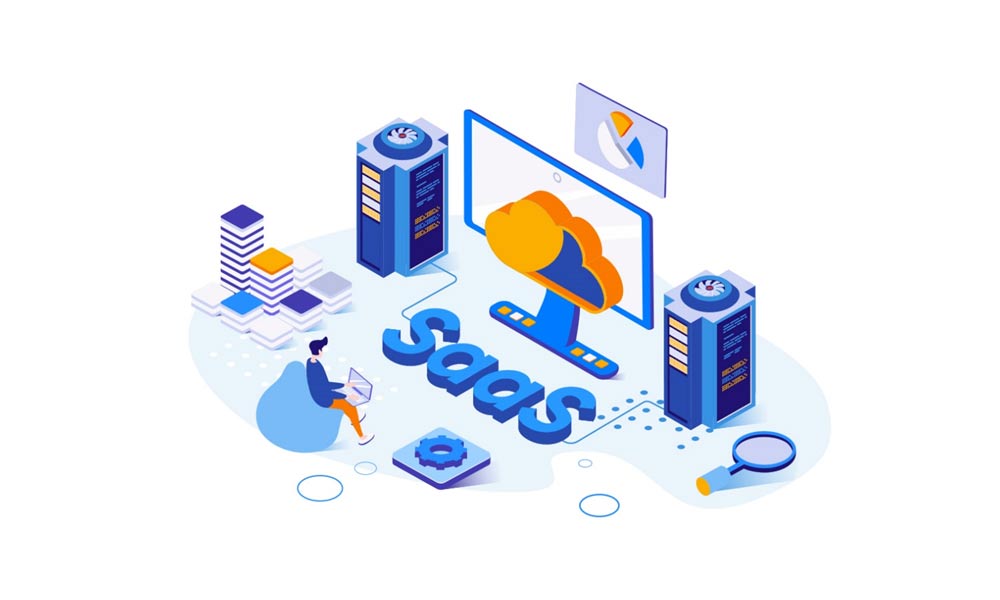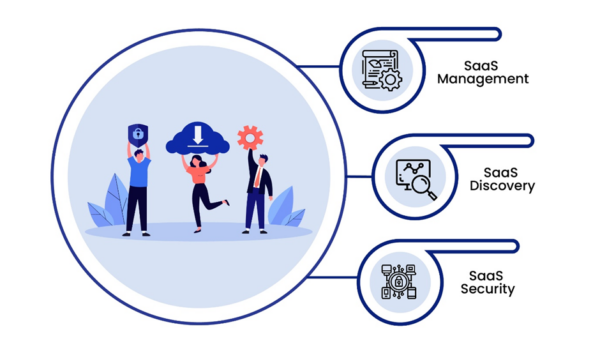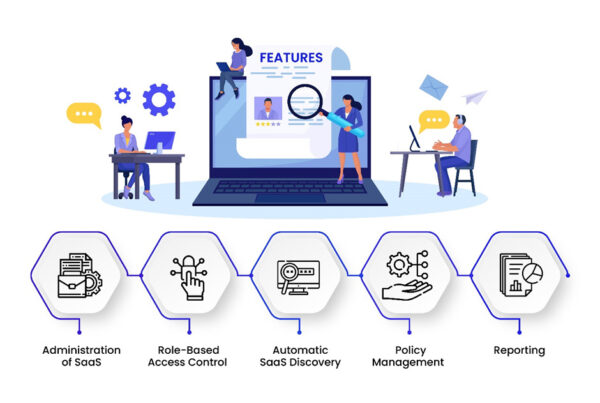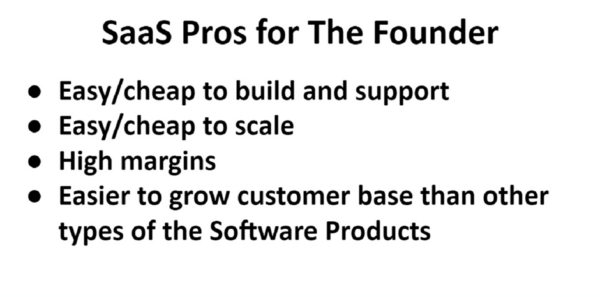SaaS is a collection of web-based applications that provide software as a service. A SaaS provider hosts, maintain and upgrades software through the internet on its servers. SaaS is a centrally hosted, subscription-based software licensing model.
The broad adoption of the SaaS model of technology deployment is, without a doubt, a significant driver of technological disruption across businesses. According to studies, the worldwide SaaS industry is likely to reach or surpass USD 623 billion by 2023. Small and medium-sized firms working in these industries are the primary beneficiaries of SaaS across all industrial sectors.
While prominent players have certain benefits, smaller companies revolutionize their businesses. They have access to sophisticated tools through SaaS, allowing them to compete with the best in the market without worrying about expenses. They pay for the resource they use with SaaS, scale up or down based on business needs, and experience hassle-free technology implementation without needing dedicated monitoring of employees. This enables them to provide the greatest services to clients by utilizing the exact digital solutions as industry leaders.
What is SaaS management?
SaaS administration is the process of keeping track of and exercising control over all of your organization’s SaaS applications. This involves acquiring, onboarding, and offboarding SaaS services and licensing and renewing subscriptions.
Because there are so many SaaS applications, your company’s IT staff requires help monitoring and controlling the SaaS stack properly. Many companies determine their SaaS footprint since they don’t have SaaS management. There is a role for SaaS management tools to play in this scenario.
The administration of SaaS is an essential component of IT operations. Companies implement a SaaS management platform if they emphasize using cloud-based applications significantly.
Integrating a VSaaS solution alongside your SaaS management platform can enhance security oversight by providing scalable, cloud-based video surveillance tailored to your business needs.
What exactly is the SaaS management platform?
SaaS and management refer to administering SaaS. SaaS Management encompasses all technological infrastructures. The SaaS management platform is defined by the SaaS, SaaS management technology platform (SMP).
Why do organizations need a SaaS management platform?
SaaS is the usual software distribution paradigm for businesses. SaaS management platform is gaining popularity rapidly; your firm needs a SaaS management plan.
SaaS solutions are one of the fastest-growing categories in the IT industry. Although many firms migrated to SaaS as part of their digital transformation strategies, the SaaS industry boomed during the epidemic.
SaaS services are intended to give enterprises a low-cost and reliable model.
On the other hand, increased dependence on SaaS services produced the worries that SaaS suppliers promised.
Due to the simplicity of acquisition, many teams or even employees within a company acquire SaaS subscriptions independently. This results in many duplicate apps and features, resulting in considerable SaaS costs and waste for businesses.
Today, SaaS management necessitates enterprises to experience and utilize their SaaS offerings.
SaaS management provides the following advantages:
- Keep an eye on SaaS application costs
- Help manage SaaS license
- Plan SaaS renewal
- Manage SaaS vendor relationships and contracts
- Provide transparency into all SaaS purchases
- Reduce and prevent shadow IT
- Protected cloud apps
- Inventory the active SaaS applications
- Enhance IT organization-wide cooperation
Benefits of adopting SMP
Cloud-based SaaS Management Platform offers several advantages over earlier software distribution approaches.
SaaS spend analysis and visibility
Have complete visibility over the applications purchased and the individuals paying money.
Maintain track of your SaaS expenditures
Zluri’s article on optimizing your SaaS spend says that along with establishing internal procedures and clearance, your company needs a system for managing SaaS.
SaaS applications require no physical distribution
The SaaS is accessible online. You aren’t required to ship a physical distribution via a storage device.
The online distribution of SaaS makes the program easier to acquire, obtain, and distribute. The SaaS is upgradeable online.
A long-term commitment is unnecessary
You utilize a subscription-based SaaS on an as-needed basis and are free to cancel your membership anytime or continue it as long as you like.
You also swiftly adopt the most recent SaaS with enhanced functionality and aesthetics and dispose of the older ones.
SaaS requires no specialized IT skills or training.
SaaS doesn’t require IT specialists for deployment because it is accessible online and doesn’t require physical storage. Most SaaS programs are simple to implement, and their online self-help documentation is straightforward and user-friendly.
SaaS is economical
The low-cost SaaS is a compelling option for most business owners. Users often take advantage of the low-cost SaaS by subscribing on an as-needed basis, with no need to continue for a set duration.
Easy scalability of SaaS
SaaS doesn’t require physical storage, and with cheap cost and online availability in the cloud, you often install SaaS across your business without incurring high costs for scaling up. It requires no significant planning for implementation and is scalable.
SaaS management strategies
Implement the following SaaS management strategies if your firm intends to capitalize on the SaaS management platform.
Reduce and prevent Shadow IT
Increased lines of business, teams, and individual users purchasing SaaS apps generate shadow IT directly. Separate judgments on the acquisition of SaaS are harmful to the cause. The Central IT team is required to decide on the purchase of SaaS.
SaaS license management
Before subscribing to numerous SaaS with growing users, you must implement a licensing management policy. Unattended unused SaaS licenses cause security risks and other problems.
SaaS renewal management
To prevent paying for SaaS that you no longer use, you need to be able to control auto-renewing subscriptions.
Compliance, data security, and risk reduction for SaaS
Your IT policy has to ensure data protection, risk mitigation, and national and international IT legislation compliance.
Utilization and value of SaaS
SaaS has to be capable of returning the value. Assess and measure SaaS uptake and usage. SaaS has achieved worldwide appeal due to its numerous advantages.
What makes SaaS as a platform unique?
The unique selling proposition of SaaS as a platform includes the following:
- Physical distribution is not required for SaaS
- SaaS consumers are not required to make long-term commitments
- SaaS requires neither technical expertise nor training.
- SaaS applications are economical
- SaaS scaled up rapidly and simply
- SaaS reduces and eliminates Shadow IT
- SaaS is an authorized and licensed application administration
- Users using SaaS are not required to pay for maintenance and updates
- The installation of hardware and software is not required for SaaS applications
- SaaS is a subscription-based strategy that immediately saves time and resources
- SaaS is immediately accessible for monthly subscriptions
- It provides scalability, accessibility from anywhere at any time, ease of deployment and usage, cost savings, heightened security, and continuous upgrades
Because SaaS is simple to use and quick, more businesses are adopting it. SaaS enables end-users to build, upgrade, and deploy software fast, accelerating corporate operations. SaaS creates value via adaptability.
Centralized SaaS management
SaaS management tools integrate data into one system, enabling IT to manage policies, fix violations, examine all assets and users, and monitor administrator activities across all apps from a single spot. Using SaaS management tools, you are able to also see your whole IT estate, including shadow IT, to make wiser, data-driven decisions.
Solid SaaS management platform, for instance, makes it easy to manage your SaaS from a unique, straightforward, and thorough dashboard. You are able to quickly determine which programs you use, how frequently, and how much you spend on each.
An all-inclusive SaaS management platform is going to replace many solutions soon and become the backbone of your IT department. The value of SaaS management software increases as you utilize and extend more of its capabilities due to centralized SaaS visibility, automation, and security on a single platform.
What features are required in a SaaS management software
The tools should accomplish at least three essential tasks:
- Automated application discovery inside a company’s infrastructure
- Managing and automating administrative tasks, including onboarding and offboarding
- Providing a single location for implementing SaaS portfolio app and data security regulations.
It is conceivable that additional features and capabilities are introduced. Some systems, for instance, enable administrators to develop a library of approved applications that workers often download, measure employee adoption and usage of apps, estimate future demands, and give SaaS app recommendation services to eliminate app overlap and optimize spending. Numerous automation functions rely on SaaS integrations; thus, explore the integrations provided by any SaaS management platform you are contemplating.
Experts recommend that businesses explore SaaS management software
- If they observe an increase in subscription fees
- If numerous departments begin to purchase the same software, the cost per department will decrease.
- If security staff are concerned about the safety and compliance of the applications in use, review the apps
- Managing software purchases on a spreadsheet has become a headache if this is the case
Are you ready to use a SaaS Management Platform?
SaaS is the future of small company technology, as seen by its fast worldwide adoption rate. This adoption trend is primarily driven by the vast array of benefits clients receive when subscribing to sophisticated SaaS solutions with little cost and effort inputs.
Increasingly, businesses rely on SaaS apps to do their jobs. Unfortunately, the majority of companies currently utilize several SaaS solutions. A SaaS management platform will allow you to quickly offset these solutions’ downsides.
You only need a strategic technology partner to maximize the return on your SaaS expenditures by delivering a robust solution and customizing it to your specific business requirements.






Leave A Comment
You must be logged in to post a comment.